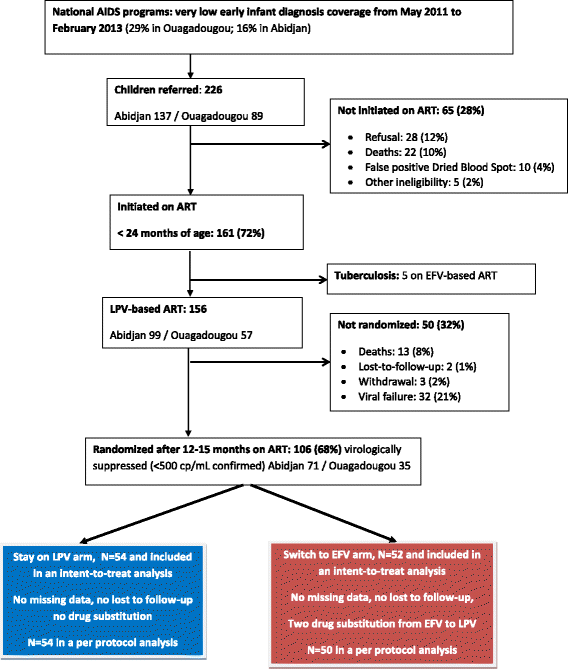Efavirenz-based simplification after successful early lopinavir-boosted-ritonavir-based therapy in HIV-infected children in Burkina Faso and Côte d'Ivoire: the MONOD ANRS 12206 non-inferiority randomised trial
- PMID: 28434406
- PMCID: PMC5402051
- DOI: 10.1186/s12916-017-0842-4
Efavirenz-based simplification after successful early lopinavir-boosted-ritonavir-based therapy in HIV-infected children in Burkina Faso and Côte d'Ivoire: the MONOD ANRS 12206 non-inferiority randomised trial
Abstract
Background: The 2016 World Health Organization guidelines recommend all children <3 years start antiretroviral therapy (ART) on protease inhibitor-based regimens. But lopinavir/ritonavir (LPV/r) syrup has many challenges in low-income countries, including limited availability, requires refrigeration, interactions with anti-tuberculous drugs, twice-daily dosing, poor palatability in young children, and higher cost than non-nucleoside reverse transcriptase inhibitor (NNRTI) drugs. Successfully initiating LPV/r-based ART in HIV-infected children aged <2 years raises operational challenges that could be simplified by switching to a protease inhibitor-sparing therapy based on efavirenz (EFV), although, to date, EFV is not recommended in children <3 years.
Methods: The MONOD ANRS 12026 study is a phase 3 non-inferiority open-label randomised clinical trial conducted in Abidjan, Côte d'Ivoire, and Ouagadougou, Burkina Faso (ClinicalTrial.gov registry: NCT01127204). HIV-1-infected children who were tuberculosis-free and treated before the age of 2 years with 12-15 months of suppressive twice-daily LPV/r-based ART (HIV-1 RNA viral load (VL) <500 copies/mL, confirmed) were randomised to two arms: once-daily combination of abacavir (ABC) + lamivudine (3TC) + EFV (referred to as EFV) versus continuation of the twice-daily combination zidovudine (ZDV) or ABC + 3TC + LPV/r (referred to as LPV). The primary endpoint was the difference in the proportion of children with virological suppression by 12 months post-randomisation between arms (14% non-inferiority bound, Chi-squared test).
Results: Between May 2011 and January 2013, 156 children (median age 13.7 months) were initiated on ART. After 12-15 months on ART, 106 (68%) were randomised to one of the two treatment arms (54 LPV, 52 EFV); 97 (91%) were aged <3 years. At 12 months post-randomisation, 46 children (85.2%) from LPV versus 43 (82.7%) from EFV showed virological suppression (defined as a VL <500 copies/mL; difference, 2.5%; 95% confidence interval (CI), -11.5 to 16.5), whereas seven (13%) in LPV and seven (13.5%) in EFV were classed as having virological failure (secondary outcome, defined as a VL ≥1000 copies/mL; difference, 0.5%; 95% CI, -13.4 to 12.4). No significant differences in adverse events were observed, with two adverse events in LPV (3.7%) versus four (7.7%) in EFV (p = 0.43). On genotyping, 13 out of 14 children with virological failure (six out of seven EFV, seven out of seven LPV) had a drug-resistance mutation: nine (five out of six EFV, four out of seven LPV) had one or more major NNRTI-resistance mutations whereas none had an LPV/r-resistance mutation.
Conclusions: At the VL threshold of 500 copies/mL, we could not conclusively demonstrate the non-inferiority of EFV on viral suppression compared to LPV because of low statistical power. However, non-inferiority was confirmed for a VL threshold of <1000 copies/mL. Resistance analyses highlighted a high frequency of NNRTI-resistance mutations. A switch to an EFV-based regimen as a simplification strategy around the age of 3 years needs to be closely monitored.
Trial registration: ClinicalTrial.gov registry n° NCT01127204 , 19 May 2010.
Keywords: Africa; Early antiretroviral treatment; Efavirenz; HIV; Infants; Lopinavir; Protease inhibitors; Randomised clinical trial; Treatment simplification; Virological outcomes.
Figures
References
-
- UNAIDS . Global report UNAIDS report on the global AIDS epidemic 2013. Geneva: UNAIDS; 2013. p. 272.
-
- UNAIDS . The Gap Report 2014. ISBN 978-92-9253-062-4. Updated September 2014. Geneva: UNAIDS; 2014. pp. 1–422.
-
- Report of the WHO Technical Reference Group, Paediatric HIV/ART Care Guideline Group Meeting. Revised treatment recommendations for infants http://www.who.int/hiv/pub/paediatric/WHO_Paediatric_ART_guideline_rev_m.... Accessed 7 Apr 2017.
Publication types
MeSH terms
Substances
Associated data
LinkOut - more resources
Full Text Sources
Other Literature Sources
Medical


